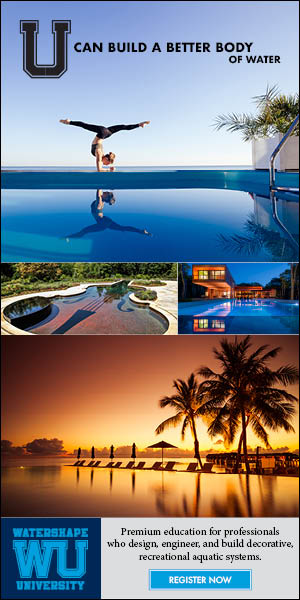ARTICLES
Advance Search
Aquatic Health
Aquatic Health, Fitness & Safety
Around the Internet
Aquatic Culture
Aquatic Technology
Artful Endeavors
Celebrity Corner
Life Aquatic
Must-See Watershapes
People with Cameras
Watershapes in the Headlines
Art/Architectural History
Book & Media Reviews
Commentaries, Interviews & Profiles
Concrete Science
Environment
Fountains
Geotechnical
Join the Dialogue
Landscape, Plants, Hardscape & Decks
Lighter Side
Ripples
Test Your Knowledge
The Aquatic Quiz
Other Waterfeatures (from birdbaths to lakes)
Outdoor Living, Fire Features, Amenities & Lighting
Plants
Ponds, Streams & Waterfalls
Pools & Spas
Professional Watershaping
Structures (Editor's Notes)
Travelogues & History
Water Chemistry
WaterShapes TV
WaterShapes World Blog
Web Links
Around the Internet
Aquatic Culture
Aquatic Technology
Artful Endeavors
Celebrity Corner
Life Aquatic
Must-See Watershapes
People with Cameras
Watershapes in the Headlines
Renolit makes RENOLIT SOLID, a reinforced PVC membrane created to renovate and waterproof decks on both residential pools as well as in aquatic facilities. This 80-mil thick membrane upgrades decks to make them waterproof and slip-resistant for safety, the company says. A “solid” solution for common deck problems including cracks, chips, peeling paint and more. Provides long-term ease of maintenance.
Learn more here.
The ability to adapt to different project parameters and conditions can require patience and a balance between conformity and standing your ground. The project pictured here, explains Scott Cummings and Benjamin Lasseter, is as a perfect example of integrating a pool and landscape design with a challenging site and discerning project team members.
Tucked into a transitional zone between residential and commercial development in central Austin, this project occupies a steeply sloped lot that descends into a natural ravine. Much of the surrounding Hill Country landscape remains untouched, lending the area a distinctly organic feel.
The home we worked on sits on one of the few undeveloped parcels left, and while many nearby houses are 20-plus years old, this residence is among the newest—at least a decade more current than its neighbors.
We were brought in early in the process to design and build the swimming pool and coordinate the landscape design. Integrating our work with the home’s architecture and structural design was a high priority from day one. The pool wasn’t an add-on or afterthought—it was embedded in the architectural DNA of the project.
We worked with John Gelkin of Austin Impressions, who, while known for high-end remodels, was beginning to venture into new construction. Having collaborated with him on several remodels where we added or upgraded pools, he invited us into this project early on in the process. That timely integration made a huge difference, especially in coordinating with his design-build team, including their building designer and structural engineer.
Later in the process, Cornerstone Architects was brought in to complete the architectural aspects of the home. Despite the shift in direction, the project maintained continuity in vision. We designed both the pool and the surrounding landscape, although the client chose to have his own commercial landscape company handle the installation.
This required detailed design documentation and coordination to ensure the execution matched the intent.
SUSTAINABLE CORE
Sustainability was at the heart of the design program. The home incorporates extensive green technologies, including a massive rainwater harvesting system, solar electric panels, and solar thermal water heating. Constructed entirely of insulated concrete forms (ICFs), the house is remarkably energy efficient and designed to minimize strain on municipal infrastructure.
While the pool wasn't equipped with its own dedicated solar system, it benefits from the home’s solar array and battery backups, drawing its power—along with the rest of the home—from renewable sources.
We embraced energy efficiency in the pool system as well: variable-speed pumps, high-efficiency gas heaters, a large cartridge filter to eliminate the need for backwashing, and a circulation design that minimizes energy and water waste.
DESIGN INTEGRATION
Architecturally, the pool is integrated directly into the footprint of the home. Although it is structurally separate from the house, it is a visual extension of the home’s contemporary design. This spatial harmony was intentional. The roof opening, the skylight above the pool, the catch basin below—all echo the pool’s clean rectangular geometry, creating a visual rhythm throughout the property.
A sliding door system opens the home’s main living area directly onto the pool terrace, transforming it into an indoor-outdoor space. The same flooring material flows from inside to out, blurring the lines between interior and exterior. Sculptural planters, circular elements, and layered vistas tie it all together, providing moments of visual interest and architectural punctuation.
The pool itself is 14 feet wide by 20 feet long, featuring a perimeter overflow on all four sides—including a vanishing edge and a tricky step detail. One challenge we faced was the limited space available for a catch basin large enough to handle the volume from the overflow. Our solution was a dual-level system: the pool and spa both overflow into a single catch basin, which then drains to a surge tank concealed beneath the deck, near the equipment room.
The spa, a seven-foot circle nestled into the rectangular pool terrace, provides a graceful counterpoint to the right angles and straight lines of the house and pool. These subtle geometric contrasts create visual balance and elevate the space’s sculptural quality.
WHITE BRIGHT
The visual finish of the pool is striking. Initially, we envisioned a dark interior finish against a lighter deck. But after discussions with the interior designer and the client, we flipped the palette: a luminous white pool set against a darker, richly textured deck material.
We used Oceanside Glass Tile’s "Muse" series in white, complemented by a white quartz finish below the waterline. Despite the light color, the pool reflects light beautifully, in part due to the darker deck surroundings and the interplay of sunlight through the skylight above. The effect is both crisp and ethereal—a sculptural centerpiece within the broader architectural composition.
Structurally, this project was one of the more unique and complex we've encountered. The pool was constructed within four ICF walls, effectively insulating it on all sides. The floor, however, was close enough to grade that we treated it more like a traditional shell. The coping sits nearly 13 feet above grade, and the deck system is suspended between the house and pool structures via steel beams and pans, which we then surfaced with the deck material.
Because everything—house, deck, pool—sits on a shared foundation, we were able to control movement far better than in typical builds.
The equipment room, located beneath the spa, houses the full suite of pool systems, a large aquarium system, and rainwater collection tanks. Getting to it is an adventure in itself: a descent down a hill, around the pool, and down another set of stairs into the room.
We installed high-efficiency heaters, flush wall fittings, and two oversized UV units that allow for extremely low chlorine usage while maintaining crystal-clear water. Floor returns are integrated into the pool’s design, with a Paramount MDX system in the spa. With a white-on-white palette, even the fittings virtually disappear.
The pool is four feet deep throughout, with a small Baja shelf for lounging.
LONG ROAD TO COMPLETION
This project started in 2016 and wasn’t completed until the height of the COVID-19 pandemic—nearly four years in the making. Because our scope was limited to the pool and some design elements, our schedule was intermittent. We'd come in for a month at a time, complete our tasks, and step back until needed again.
At one point, a unilateral decision was made to drop the house’s finished floor elevation by four feet—after our entire design had been approved. That shift drastically altered our vertical alignments, requiring a complete redesign of the driveway and courtyard transitions.
What was once a mostly at-grade sunken courtyard became a deep basin, demanding new creative solutions. The stairway, planters, and planting palette evolved to create a lush and inviting descent, softening the experience and maintaining visual continuity.
Despite the many complexities, delays, and unexpected turns, the final result is a space that feels incredibly cohesive—visually, functionally, and emotionally. While the path there was far from linear, the outcome was worth every bit of effort.
We often talk about water as art, and I truly believe this project embodies that idea. This pool isn’t just a place to swim—it’s a central sculptural element, an architectural statement, and an emotional focal point of the home. The fact that it also happens to be sustainable, efficient, and inviting makes it all the more rewarding.
Scott Cummings, RLA, ASLA, CBP is partner and principal landscape architect for Design Ecology in Austin, TX. He established the company in February 2009 with partner Ben Lasseter, IWI, who serves as president of construction.
Kevin Cobabe takes great pride in creating equipment sets that not only look clean, but reflect an artisan touch in function and appearance. That’s why on all of his projects he finishes with a flare by painting the equipment pad plumbing, a step that protects the pipes and gives the work a professional look.
Painting pipes on pool and spa equipment pads is one of those little details that separates the pros from the pretenders. I’ve been building pools since 1986, and one of the first things my brother-in-law taught me was: paint your pipes. Protect them from UV rays, keep them clean, and give your work that finished look that says, “I cared enough to go the extra mile.”
Let’s start with the practical side of things. The Uniform Plumbing Code (UPC), Section 312.14, covers protection of piping materials and structures. It says PVC piping must be protected from direct sunlight—unless it’s covered with water-based synthetic latex paint or wrapped with enough tape. That means, like it or not, you need to put a coating of some kind on your PVC pipes.
Sure, I’ve heard the arguments that it’s somehow unnecessary: “I’ve seen PVC out there for 20 years and it’s fine!” And that’s true, sometimes it holds up. But based on my experience—and trust me, I’ve seen plenty—PVC can degrade from UV exposure. Leave a piece of pipe baking in the sun, and after a while, drop it on the ground—it’ll shatter like glass. New PVC? Drop it, and it’ll bounce. That’s the difference.
COMMON PRACTICE & COMMONSENSE
That’s why, from the very beginning of my career, I’ve painted every set of equipment—indoor, outdoor, it didn’t matter. It just became my thing. A clean equipment pad is a happy equipment pad.
Painting also helps you keep things organized. If so inclined you can even use different colors to give yourself or your clients visual cues. Darker shades for suction lines, lighter ones for returns, for example.
I even built a pool once where I really went all out: red for jet pumps, yellow for solar, blue for circulation, aqua green for the vanishing edge (pictured above). That’s not in the code—it was just me wanting to flex my creative side.
You certainly don’t have to that far to realize there is an aesthetic element to equipment pads. A neat, clean layout makes a statement. Nobody likes to see primer and blue glue smudged everywhere, like a Smurf murder scene, as some people call it. Painting those pipes shows you cared. It’s that extra step that tells the world you planned this project, you executed it well, and you put your signature on it.
And it’s not that hard—or expensive. Like any painting job, it’s 90% prep and 10% spraying. We put Ramboard down on the ground before we start, mount all the equipment on top, and slide the Ramboard out when we’re done. That keeps the floor clean. Once the plumbing is done, all you have to do is tape off the valves, toss a couple of rags over the equipment, and get to spraying. I use regular Rust-Oleum, no primer needed. One coat usually does the trick, though sometimes you’ll want to go around at the end and touch up scratches or scuffs from adjustments.
COLOR FAST
When it comes to color, I try to match the equipment brand’s theme to keep a nice monochrome look. Pentair is almond. Jandy is smoke gray. Hayward has an earthy brown tone. Sta-Rite is black. Most of the pools I’ve built—99%—have been single-color. But every now and then I’ll get a creative client and we’ll have some fun with colors.
Some repair techs grumble because they have to scrape the paint off before making repairs. But honestly, it’s easy enough to handle—use a razor blade at a ninety degree angle to the pipe as well as at a 45 to the scraping surface and it comes off quick. It’s a small price to pay for the confidence a painted pad brings your client. The cleaner everything looks, the more confidence it gives them in you as a professional.
Painting your pipes is the cherry on top. It’s like putting the star on the Christmas tree at the end of the project. That’s why I always tell my plumbing classes: painting the pipes is like signing your name. You put in the time and effort—make it yours.
So yeah, painting pool pipes isn’t just about following code. It’s about taking pride in your craft. And that’s why I always say: if you care about your work, paint your pipes.
Kevin Cobabe is president of Dynamic Pool & Spa Construction, a high-end watershaping firm based in Redondo Beach, CA. He is also a founding member of the International Watershape Institute (IWI), faculty member for Watershape University and a regular contributor to watershapes.com and the Ask the Masters Facebook group. He is also a master "gravy sommelier".
Every so often a project comes along that’s less about creating a backyard paradise and more about uncovering—and correcting—the sins of the past. That was certainly the case for George Frederick with a recent remodel in Winston-Salem, NC, where badly misguided original construction and a cosmetic rehab left a new homeowner with a failing pool.
...
Magic Plastics is pleased to offer the CR2 Check Valve to protect against corrosion in high-value systems like heat exchangers. Built for durability, performance, and easy maintenance, the CR2 check valve is the no-compromise solution for reliable backflow prevention, the company says. With a Hastelloy C-276 spring, the CR2 check valve stands-up to harsh chemicals and corrosive water conditions that quickly wear down standard valves.
Learn more here.
Saunas have been an integral part of human culture for thousands of years, with origins tracing back to ancient Finland two millennia ago. As Dave Peterson explains, saunas are catching on throughout much of the modern world, a rise driven by well-documented health benefits combined with aging consumer demographics that have among other trends led to a surge in “social saunas.”
...
In the deep, lightless realms of the Pacific Ocean—where pressure crushes and sunlight never penetrates—scientists have made a groundbreaking discovery: dark oxygen. Unlike the oxygen we are familiar with, produced by plants and photosynthesis, dark oxygen forms without light, deep in the sediments of the ocean floor.
...
La Spezia, Italy, is a place rich in history, architectural beauty, religious tradition and maritime heritage. One of its latest modern attractions is the Palio del Golfo Artwork—a work that pays homage to the rich local culture and traditions, while also pointing toward the future.
...
Fluidra is introducing its Jandy X-Series AOP Systems — an innovative line of supplemental pool water treatment solutions, the company says. Using Advanced Oxidation Process (AOP) that combines UV-C and Ozone technologies, the X-Series delivers superior oxidation power, eliminating what chlorine alone can’t, the company says. Powered by DEL technology, the Jandy X-Series AOP line includes three in-line models for pools up to 50,000 gallons — all certified to NSF/ANSI/CAN 50 standards.
Learn more here.













Remembering Andrew A. Pansini